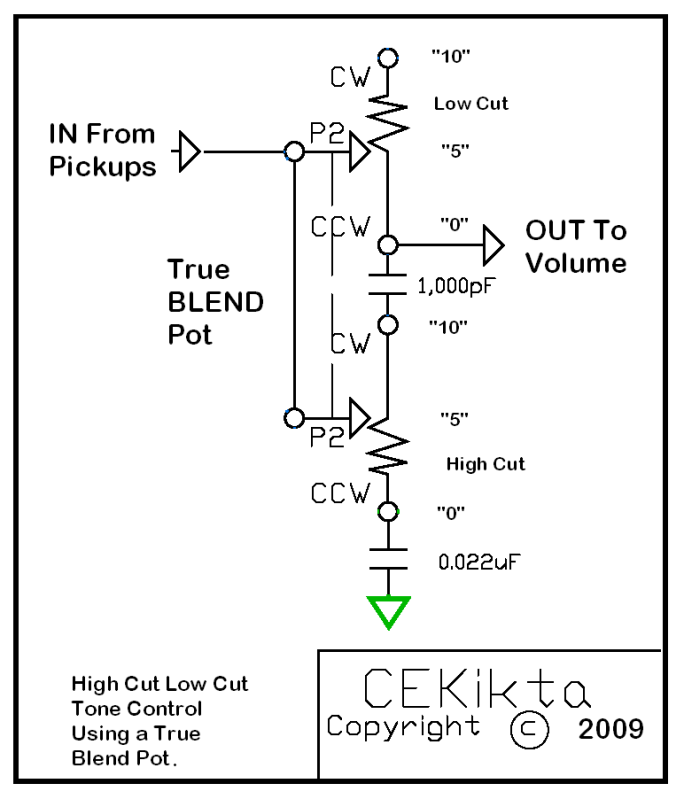|
|
Post by ChrisK on Sept 5, 2009 23:42:10 GMT -5
tedfixxThis module uses a true Blend pot. From "5" to "0" its a linear high cut tone control. From "5" to "10" it's a linear low cut tone control. 
|
|
|
|
Post by hellcatcustoms on Aug 12, 2016 11:16:14 GMT -5
Ok I'm new, this seems like something I want to play with but looking at the diagram vs hard parts I'm wanting to make sure I'm not reading it wrong.....do you have a photo of the pot and caps all put together?
What I'm hoping this is, is one pot set up to cut lows if turned one direction and cut highs of turned the other....am I correct?
|
|
|
|
Post by newey on Aug 12, 2016 11:29:06 GMT -5
Correct. No, and unfortunately, ChrisK is no longer on this Earth, as they say. So far as I am aware, he never built this module, so no archived photos. Chris K's diagrams were pretty stylized (and, just plain pretty as well). Best if you can take a stab at drawing it up and we'll correct if needed. I could do a wiring diagram but it will be a few days, probably. I noted that the link in ChrisK's post is broken. Here's where the link went: ChrisK's "Blend and Pan pots"The above is required reading. The upshot of it all is that you need to buy the real-deal Fender OEM part number to be sure you don't get a pan pot. |
|
|
|
Post by sumgai on Aug 12, 2016 11:46:18 GMT -5
As Chris would've said:
Akshully..... this is two separate potentiometer elements combined on one shaft, so technically speaking, it's not just one pot. Otherwise, you would not be able to insert that capacitor between the two elements. What it means is that no change in resistance takes place between 0 and 5 on one element, and the same holds true for the other element, between 5 and 10. Still and all, it is only one physical component that you'll mount in your axe.
helly, you really do want that "special" Fender part, because a lot of money has been wasted over the years by many Nutz, trying to buy the correct part from other sources. Invariably, they ended up with something that didn't work as needed, nor (usually) as advertised.
HTH
sumgai
|
|
|
|
Post by JohnH on Aug 12, 2016 14:58:04 GMT -5
|
|
|
|
Post by b4nj0 on Aug 12, 2016 16:16:28 GMT -5
Here's another take on this theme. It is a link to a .jpg of the circuit of my Access Electronics Session 15-30 amplifier. There are three pots, RV1 etc etc. RV1 is the volume and the other two are treble and "mid-bass". The latter control cuts the bass one way and mids the other with a centre detent. This caused puzzlement in the reviews at the time (1980), but it is a very effective control. The 15-30 was a booteek amp long before the notion was more widely conceived. ChrisK's circuit displays "kiss" technology though and there is a lot to be said for that. The amp's designer (Stewart Ward) is still going strong, and is an innovative audio electronics designer that moved on to impressive achievements with solid state audio design directly after ceasing the 400 strong production run of the 15-30. There is much of interest to read under the "history" and "Geartalk" links on the Award-Session website. Sorry that I did not post the actual .jpg, but I do not presume to have permission. Warning, contains glass ware. www.award-session.com/images/1530.JPGe&oe... |
|